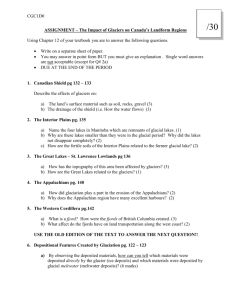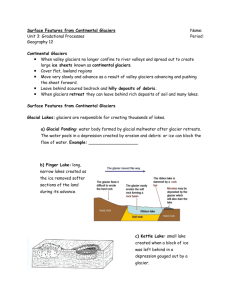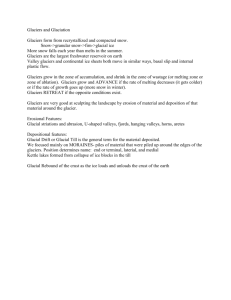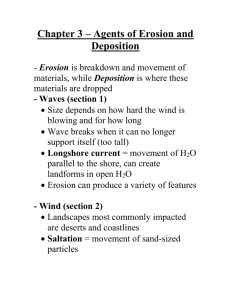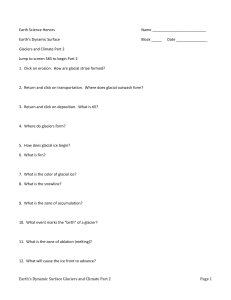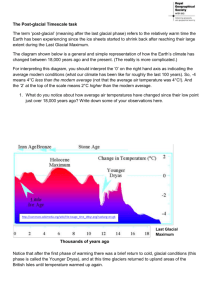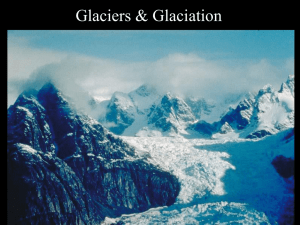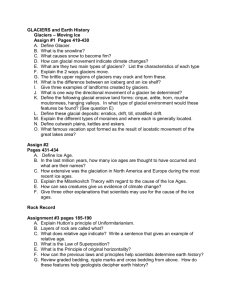Chapter 17 - Cenozoic - Quaternary
advertisement
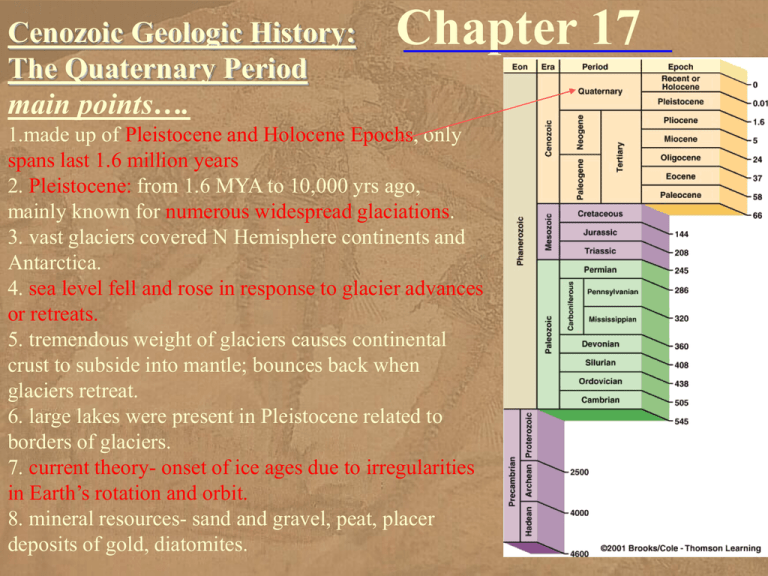
Cenozoic Geologic History: The Quaternary Period main points…. Chapter 17 1.made up of Pleistocene and Holocene Epochs, only spans last 1.6 million years 2. Pleistocene: from 1.6 MYA to 10,000 yrs ago, mainly known for numerous widespread glaciations. 3. vast glaciers covered N Hemisphere continents and Antarctica. 4. sea level fell and rose in response to glacier advances or retreats. 5. tremendous weight of glaciers causes continental crust to subside into mantle; bounces back when glaciers retreat. 6. large lakes were present in Pleistocene related to borders of glaciers. 7. current theory- onset of ice ages due to irregularities in Earth’s rotation and orbit. 8. mineral resources- sand and gravel, peat, placer deposits of gold, diatomites. Cenozoic Time Scale • The geologic time scale – for the Cenozoic Era • The Pleistocene Epoch – from 1.6 million to 10,000 years ago – takes up most of the Quaternary, – and is thus the main focus of this section Pleistocene—Holocene Tectonism and Volcanism • The Pleistocene Epoch is best known for glaciation, – but it was also a time – of volcanism and tectonic activity • For instance, continuing orogeny took place – in the Himalayas of Asia and the Andes Mountains in South America, – and deformation at convergent plate boundaries – proceeded unabated – in the Aleutian Islands, Japan, the Philippines, and elsewhere Uplift and Deformation • Interactions between – – – – the North American and Pacific plates along the San Andreas transform plate boundary produced folding, faulting, and a number of basins and uplifts • Marine terraces – covered with Pleistocene sediments – attest to periodic uplift in southern California Marine Terraces • Marine terraces on the west side of San Clemente Island, California • Each terrace represents a period when that area was at sea level • The highest terrace is now about 400 m above sea level Pleistocene Glaciation • Study of Pleistocene glaciation helps us – – – – – understand the causes of an ice age, may clarify some aspects of long-term climatic changes, and perhaps tell us something about global warming • Furthermore, glaciers are dynamic systems; • just like other elements of the hydrosphere, – they are continually adjusting to change, – and thus provide another example of – the systems approach to understanding Earth history Biblical Deluge Versus Glaciers • In hindsight it is difficult to believe – – – – that many naturalists of 165 years ago refused to accept the evidence indicating that widespread glaciation had occurred during the recent past • Many invoked the biblical deluge – – – – to explain the large boulders throughout Europe far from their source; whereas others thought the boulders were rafted by ice during vast floods Louis Agassiz • But in 1837, – – – – Swiss naturalist Louis Agassiz argued convincingly that the large displaced boulders as well as polished and striated bedrock and Ushaped valleys – found throughout Europe and elsewhere – resulted from huge masses of ice – moving over the land Glacial Features • Features seen in areas once covered by glaciers • glacial polish – the sheen • striations – scratches • These features are convincing evidence that – a glacier moved over these rocks – in Devil’s Postpile National Monument, California Glacial Sediment • Glaciers typically deposit poorly sorted nonstratified sediment like this – Other processes yield similar deposits – but their association with glacial polish, striations, and other features is definitive Glaciers Three km Thick • From such glacial features as • the distribution of moraines, • erratic boulders, • and glacial striations, • Glacial polish – geologists have determined that • at their greatest extent – Pleistocene glaciers as much as 3 km thick – covered about three times – as much of Earth's surface – as they do now Glaciers in North America • Centers of ice accumulation – and maximum extent – of Pleistocene glaciers – in North America Glaciers in Europe • Centers of ice accumulation – and directions of ice movement – during the maximum extent – of Pleistocene glaciers in Europe Four Glacial Stages • Each glacial advance – was followed by retreating glaciers – and warmer climates • The four glacial stages, • • • • the Wisconsinan, Illinoian, Kansan, and Nebraskan, – are named for the states representing the southernmost advance – where deposits are well exposed Three Interglacial Stages • The three interglacial stages, – the Sangamon, Yarmouth, and Aftonian, – are named for localities – of well exposed interglacial soil and other deposits • Recent detailed studies of glacial deposits – indicate, however, that there were – an as yet undetermined number – of pre-Illinoian glacial events – and that the history of glacial advances and retreats – in North America – is more complex than previously thought Succession of Deposits • Idealized succession of deposits and soils – developed during the glacial and interglacial stages Advances in Europe • Six or seven major glacial advances and retreats – are recognized in Europe, – and at least 20 major warm–cold cycles – can be detected in deep-sea cores • Why isn't there better correlation – among the different areas – if glaciation was such a widespread event? • Part of the problem is that – glacial deposits are typically chaotic mixtures – of coarse materials that are difficult to correlate Deep-Sea Stratigraphy • Until recently, the traditional view – of Pleistocene chronology – was based on sequences of glacial sediments on land • During the early 1960s, however, – new evidence from ocean sediment samples – indicated that numerous climatic fluctuations – occurred during the Pleistocene Evidence for Climatic Fluctuations • Evidence for these climatic fluctuations – comes from changes in surface ocean temperature – recorded in the shells of planktonic foraminifera, – which sink to the seafloor after they die – and accumulate as sediment • One way to determine past changes – in ocean surface temperatures – is to determine whether planktonic foraminifera – were warm- or cold-water species 1. Response to Temperature • Many are sensitive to variations in temperature – and migrate to different latitudes – when the surface water temperature changes • For example, the tropical species – Globorotalia menardii is present or absent – within Pleistocene sediment samples, – depending on what the surface water temperature was at the time • During periods of cooler climate, – it is found only near the equator, – while during times of warming – its range extends into the higher latitudes 2. Coiling Direction • Some planktonic foraminifera species – change the direction they coil during growth – in response to temperature fluctuations • The Pleistocene species – Globorotalia truncatulinoides coils predominantly – to the right in water temperatures above 10°C – but coils mostly to the left in water below 8°-10°C • On the basis of changing coiling ratios, – geologists have constructed detailed climatic curves – for the Pleistocene and earlier epochs 3. Oxygen Isotope Ratio • Changes in the O18-to-O16 ratio – preserved in the shells of planktonic foraminifera – also provide data about climatic events • The abundance of these two oxygen isotopes – in their calcareous (CaCO3) shells – is a function of the oxygen isotope ratio in water molecules – and water temperature when the shell forms • The ratio of these two isotopes – reflects the amount of ocean water stored – in glacial ice Lighter Isotopes in Glacial Ice • Seawater has a higher O18-to-O16 ratio – than glacial ice – because water containing the lighter O16 isotope – is more easily evaporated – than water containing the O18 isotope • Therefore, Pleistocene glacial ice – was enriched in O16 relative to O18, – while the heavier O18 isotope – was concentrated in seawater Climate Change from Isotopes • The declining percentage of O16 – and consequent rise of O18 in seawater – during times of glaciation – is preserved in the shells of planktonic foraminifera • Consequently, oxygen isotope fluctuations – indicate surface water temperature changes – and thus climatic changes Discrepancies • Unfortunately, geologists have not yet – been able to correlate – these detailed climatic changes – with corresponding changes recorded – in the sedimentary record on land • The time lag between the onset of cooling – and any resulting glacial advance – produces discrepancies between – the marine and terrestrial records Correlation Unlikely • Thus, it is unlikely – that all the minor climatic fluctuations – recorded in deep-sea sediments – will ever be correlated – with continental deposits Onset of the Ice Age • The onset of glacial conditions – – – – – actually began about 40 million years ago when surface ocean waters at high southern latitudes rapidly cooled, and the water in the deep-ocean became much colder than it had been previously • The gradual closure of the Tethys Sea – during the Oligocene – limited the flow of warm water – to higher latitudes Ocean Surface Temperature • Fluctuations in O18-toO16 isotope rations – from a sediment core in the western Pacific Ocean – reveal changes in ocean surface temperatures – during the last 58 million years – A change from warm to colder conditions – took place 35 million years ago Warm-Cold Cycles • Oxygen isotope ratios (O18 to O16) – – – – – from deep-sea cores reveal that Earth has had 20 major warm-cold cycles during the last 2 million years during which the temperature fluctuated by as much as 10°C • Studies of glacial deposits – attest to at least four major episodes of glaciation – in North America – and six or seven similar events in Europe Cool Summers Wet Winters • During glacial growth, – – – – those areas covered by, or near glaciers experienced short, cool summers and long, wet winters but areas distant from glaciers had varied climates • When glaciers grew and advanced, – lower ocean temperatures – reduced evaporation rates – so most of the world was drier than it is now • But some now arid areas were much wetter during the Ice Age Cold-Belt Expansion • For instance, the expansion of the cold belts – – – – at high latitudes compressed the temperate, subtropical, and tropical zones toward the equator • Consequently the rain – – – – that now falls on the Mediterranean then fell farther south on the Sahara of North Africa, enabling lush forests to grow in what is now desert Warming Trend • Studies of • Pollen, • tree-rings, • and the advances and retreats of valley glaciers – have yielded a wealth of information – about the Northern Hemisphere climate – for the last 10,000 years • That is, since the time the last major continental glaciers • retreated and disappeared • Data from pollen analysis – indicate a continuous trend – toward a warmer climate – until about 6000 years ago Little Ice Age • The most recent glacial expansion, – – – – – the Little Ice Age between 1500 and the mid- to late 1800s, was a time of generally cooler temperatures, glacial expansion, and cooler, wetter summers • It had a profound effect on – – – – the social and economic fabric of human society, accounting for several famines as well as migrations of many Europeans to the New World Glaciers—What Are They and How Do They Form? • Geologists define a glacier – as a mass of ice on land that moves by plastic flow • internal deformation in response to pressure – and by basal slip • sliding over its underlying surface • In short, glaciers as moving solids – are capable of significant – erosion, transport, and deposition of sediment Continental Glacier • Aerial view of the eastern margin of the continental glacier covering most of Greenland • It is much smaller than the ones in Antarctica, • but even so it covers more than 1,800,000 km2 • Its maximum thickness is about 3350 m Valley Glacier • The terminus of this valley glacier in Switzerland is about 22 km in the distance The Pleistocene was also a time when small valley glaciers were more common in mountain ranges Glaciation and Its Effects • Huge glaciers moving over Earth's surface – reshaped the previously existing topography – and yielded many distinctive glacial landforms • As glaciers formed and wasted away, – – – – sea level fell and rose, depending on how much water was frozen on land, and the continental margins were alternately exposed and water covered Ice-Scoured Plain • Erosion by continental glaciers – formed this ice-scoured plain – in the Northwest Territories of Canada • Notice the low relief – and extensive bedrock exposures Erosion by Valley Glaciers • Pleistocene valley glaciers – also yielded several distinctive landforms – such as bowl-shaped depressions on mountainsides – known as cirques – and U-shaped glacial troughs U-Shaped Glacial Trough • This U-shaped glacial trough – in Montana – was eroded by a valley glacier Cirque on Wheeler Peak • The bowl-shaped depression on Wheeler Peak in Nevada is a glacial landform known as a cirque • Wheeler Peak, in Great Basin National Park is distinguished by having the only active glacier in the entire Basin and Range Province Recessional Moraine • If the glacier’s terminus – should recede and then stabilize once again – another end moraine forms – known as a recessional moraine Moraines • Map of the midcontinent region – showing terminal moraines (16,000 years old) – and recessional moraines – of the most recent continental glacier to cover this region Cape Cod • By about 6000 years ago – the sea covered the lowlands – between the moraines – and beaches and other shoreline features formed Land Bridge • Large areas of today's continental shelves – were exposed – and quickly blanketed by vegetation • In fact, at the Bering Strait, – – – – Alaska connected with Siberia via a broad land bridge across which Native Americans and various mammals • such as the bison – migrated Lower Sea Level • During times of lower sea level, – – – – – rivers transported huge quantities of sediment across the exposed continental shelves and onto the continental slopes where the sediment contributed to the growth of submarine fans • As the glaciers melted, however, – – – – – sea level rose and the lower ends of these river valleys along North America's East Coast were flooded, and those along the West Coast formed impressive submarine canyons Glaciers and Isostasy • Earth's crust floats on the denser mantle below, – a phenomenon geologists call isostasy • How can rock float in rock? • Consider the analogy of an iceberg • Ice is slightly less dense than water, – – – – so an iceberg sinks part way, to its equilibrium position in water with only about 10% of its volume above the surface Adding Mass to the Crust • If the crust has more mass added to it – as occurs when • thick layers of sediment accumulate • or vast glaciers form, – it sinks lower into the mantle – until it once again achieves equilibrium • However, if erosion or melting ice – reduce the load, – the crust slowly rises by isostatic rebound Evidence of Isostatic Rebound • Evidence of isostatic rebound – can be found in formerly glaciated areas – such as Scandinavia – and the North American Great Lakes Region • Some coastal cities in Scandinavia – have rebounded enough so that docks • built only a few centuries ago – are now far inland from the shore • In Canada as much as 100 m – of isostatic rebound has taken place – during the last 6000 years Isostatic Rebound in Scandinavia • The lines show rates of uplift in centimeters per century Isostatic Rebound in Eastern Canada • Uplift in meters • during the last 6000 years Pleistocene Lakes in the West • Pleistocene lakes in the western United States – Lake Missoula was a proglacial lake, – whereas the others shown were pluvial lakes Great Salt Lake and Death Valley • The present Great Salt Lake – is simply a shrunken remnant – of the once much larger Lake Bonneville • Death Valley • on the California–Nevada border – – – – is the hottest, driest place in North America, yet during the Wisconsinan it supported Lake Manly, another large pluvial lake Lake Bonneville • Wave-cut cliffs, beaches, deltas – and various lake deposits • along with fossils of freshwater organisms – attest to the presence of these lakes • Lake Bonneville • with a maximum size of about 50,000 km2 • and at least 335 m deep – was a large pluvial lake; – the vast salt deposits of the Bonneville Salt Flats • west of Salt Lake City, Utah, – formed when parts of this ancient lake dried up Varves • Deposits in lakes adjacent to or near glaciers – – – – vary considerably from gravel to mud, but of special interest are the finely laminated mud deposits consisting of alternating dark and light layers • Each dark–light couplet is a varve – representing an annual deposit Characteristics of Varves • The light-colored layer of silt and clay – – – – formed during the spring and summer and the dark layer made up of smaller particles and organic matter formed during the winter when the lake froze over • Varved deposits – – – – may also contain gravel-sized particles, known as dropstones, released from melting • Varves with a dropstone ice A Brief History of the Great Lakes • Before the Pleistocene, – the Great Lakes region – was a rather flat lowland – with broad stream valleys • As the continental glaciers – advanced southward from Canada, – the entire area was ice covered and deeply eroded • Indeed, four of the five Great Lakes basins – were eroded below sea level; – glacial erosion is not restricted by base level, – as erosion by running water is Glaciers Advanced Over the Great Lakes Area • In any case, the glaciers advanced far to the south, – but eventually began retreating north, – depositing numerous recessional moraines as they did so Evolution of the Great Lakes dotted lines indicate the present-day shorelines of the lakes Few Periods of Glaciation • The few periods of glaciation – recognized in the geologic record – are separated form one another – by long intervals of mild climate • Slow geographic changes – related to plate tectonic activity – are probably responsible – for such long-term climatic changes • Plate movements may carry continents – into latitudes where glaciers are possible – provided they receive enough snowfall Colliding Plates Influence Climate • Long-term climatic changes – – – – – – also take place as plates collide causing uplift of vast areas far above sea level, and of course the distribution of land and sea has an important influence on oceanic and atmospheric circulation patterns Decreasing Carbon Dioxide • One proposed mechanism – – – – – for the onset of the cooling trend that began following the Mesozoic and culminated with Pleistocene glaciation is decreased levels of carbon dioxide (CO2) in the atmosphere • Carbon dioxide is a greenhouse gas, – so if less were present to trap energy – Earth's overall temperature – would perhaps be low enough for glaciers to form The Milankovitch Theory • A particularly interesting hypothesis – for intermediate-term climatic events – was put forth by the Yugoslavian astronomer – Milutin Milankovitch during the 1920s • He proposed that – minor irregularities in Earth's rotation and orbit – are sufficient to alter the amount of solar radiation – that Earth receives at any given latitude – and hence can change climate Milankovitch theory • Now called the Milankovitch theory, – it was initially ignored, – but has received renewed interest – during the last 20 years • Milankovitch attributed the onset – of the Pleistocene Ice Age – to variations in three parameters of Earth's orbit Orbital Eccentricity • The first of these is orbital eccentricity, – which is the degree to which the orbit departs – from a perfect circle • Calculations indicate – a roughly 100,000-year cycle – between times of maximum eccentricity • This corresponds closely – to 20 warm–cold climatic cycles – that occurred during the Pleistocene Orbital Eccentricity • Earth’s orbit varies from nearly a circle • To an ellipse • and back again in about 100,000 years Axis Tilt • The second parameter – is the angle between Earth's axis – and a line perpendicular – to the plane of its orbit around the Sun • This angle shifts about 1.5° – from its current value of 23.5° – during a 41,000-year cycle Precession • Earth moves around the Sun in its orbit – while spinning on its axis, – which is tilted at 23.5° to the plane of its orbit • Earth’s axis of rotation – slowly moves – and traces out the path of a cone in space Plane of Earth’s Orbit Precession • The third parameter is – the precession of the equinoxes, – which causes the position – of the equinoxes and solstices – to shift slowly around Earth's – elliptical orbit in a 23,000-year cycle Effects of Precession • At present, Earth is closer to the Sun in January • In about 11,000 years, as a result of precession, Earth will be closer to the Sun in July Solar Energy Received • Continuous changes in these three parameters – cause the amount of solar heat – received at any latitude – to vary slightly over time • The total heat received by the planet, – however, remains little changed • Milankovitch proposed, • and now many scientists agree, – – – – that the interaction of these three parameters provides the triggering mechanisms for the glacial-interglacial episodes of the Pleistocene Cooling from Volcanic Eruptions • During large volcanic eruptions, – – – – tremendous amounts of ash and gases are spewed into the atmosphere where they reflect incoming solar radiation and thus reduce atmospheric temperatures • Small droplets of sulfur gases – remain in the atmosphere for years – and can have a significant cooling effect on the climate Climatic Effects of Volcanic Events • Several such large-scale volcanic events – have been recorded, • such as the 1815 eruption of Tambora • and the 1991 eruption of Mount Pinatubo, – and are known to have had climatic effects • However, no relationship between – periods of volcanic activity – and periods of glaciation has yet been established Quaternary Mineral Resources • Many mineral deposits – formed as a direct or indirect result – of glacial activity – during the Pleistocene and Holocene • We have already mentioned – – – – the vast salt deposits in Utah and the borax deposits in Death Valley, California that originated when Pleistocene pluvial lakes evaporated Sand and Gravel • In many U.S. states as well as Canadian provinces, – – – – the most valuable mineral commodity is sand and gravel used in construction, much of which is recovered from glacial deposits, especially outwash • These same commodities are also recovered – from deposits on the continental shelves – and from stream deposits unrelated to glaciation • Silica sand is used in the manufacture of glass, – and fine-grained glacial lake deposits – are used to manufacture bricks and ceramics Quaternary Placer Gold • The California gold rush – – – – of the late 1840s and early 1850s was fueled by the discovery of Quaternary placer deposits of gold in the American River • Most of the $200 million in gold mined – in California from 1848 to 1853 – came from placer deposits • Discoveries of gold placer deposits – in the Yukon Territory of Canada – resulted in settlement of that area Peat • Peat consisting of – – – – Semi-carbonized plant material in bogs and swamps is an important resource that has been exploited in Canada and Ireland • It is burned as a fuel in some areas – but also finds other uses, – as in gardening Summary • The Quaternary Period consists of two epochs: – the Pleistocene • 1.6 million to 10,000 years ago – and the Holocene or Recent • 10,000 years ago to the present • Although the Pleistocene – is best known for widespread glaciers, – it was also a time of volcanism and tectonism Summary • Pleistocene glaciers covered – about 30% of the land surface, – and were most widespread – on the Northern Hemisphere continents • At least four intervals – of extensive Pleistocene glaciation – took place in North America, – each separated by interglacial stages • Fossils and oxygen isotope data – indicate about 20 warm–cold cycles – occurred during the Pleistocene Summary • Areas far beyond the ice were affected – by Pleistocene glaciers • Climate belts were compressed – toward the equator, • large pluvial lakes existed – in what are now arid regions, • and sea level was as much as 130 m – lower than now Summary • Moraines, striations, outwash, – – – – – and various other glacial landforms are found throughout Canada, in the northern tier of states, and in many mountain ranges where valley glaciers were present • The tremendous weight – of Pleistocene glaciers – caused isostatic subsidence of Earth's crust Summary • When the glaciers melted, – isostatic rebound began – and continues even now in some areas • Major glacial episodes separated by – tens or hundreds of millions of years – probably stem from changing plates positions, – which in turn profoundly affect – oceanic and atmospheric circulation patterns Summary • According to the Milankovitch theory, – minor changes in Earth's rotation and orbit – bring about climatic changes – that produce glacial–interglacial intervals • The causes of short-term climatic changes • such as occurred during the Little Ice Age – are unknown • Two proposed causes – are variations in the amount of solar energy – and volcanism Summary • Quaternary mineral resources – include sand and gravel, – placer deposits of gold, – and some evaporite minerals • such as borax Geologic Time in 24-hours • the Quaternary – is only 38 seconds long – at this scale Observer • In 1774, one observer in Norway wrote, – "When at times [the glacier] pushes forward a great sound is heard – and it pushes in front of it unmeasurable soil, grit and rocks – bigger than any house could be, – which it then crushes small like sand." Quaternary: 38 Seconds • Recall our analogy of all geologic time – represented by a 24-hour clock • In this context, the Quaternary is only 38 seconds long, – but they are certainly important seconds, – because during this time our species evolved • Homo sapiens • The Pleistocene deserves special attention – It is one of the few times in Earth history – when vast glaciers were present If All Glaciers Melted • What would happen if the world's glaciers all melted? • Obviously, the water stored in them – would return to the oceans, – and sea level would rise about 70 m • If this were to happen, – many of the world's large population centers – would be flooded Diatomite • Some deposits of diatomite, • rock composed of the shells • of microscopic plants called diatoms, – formed in the West Coast states – during the Quaternary Fluctuating Climate • We now know when – – – – the Pleistocene Epoch began and ended, and we know it was a time of several intervals of glacial expansion separated by warmer interglacial periods • Furthermore, during glacial expansions – – – – more precipitation fell in regions now arid, such as the Sahara Desert of North Africa and Death Valley in California both of which supported lush vegetation, streams, and lakes Little Ice Age • During the Little Ice Age, – many glaciers in Europe extended – much farther down their valleys – than they do now Climate of the Pleistocene • The climatic conditions – leading to Pleistocene glaciation – were, as you would expect, worldwide • But contrary to popular belief – and depictions in cartoons and movies, – Earth was not as frigid as it is commonly portrayed • In fact, evidence of various kinds – indicates that the world's climate – gradually cooled – from Eocene through Pleistocene time Wetter Southwest • In North America – – – – – – a high-pressure zone over the northern ice sheets deflected storms south so the arid Southwest was much wetter than today Pollen Abundance • Pollen diagrams showing abundance – for six different trees • The pollen was recovered from • the Ferndale Bog, Atoka County, Oklahoma Neoglaciation • In fact, between 8000 to 6000 years ago – temperatures were very warm • Then the climate became cooler and moister, – favoring the growth of valley glaciers – on the Northern Hemisphere continents • Three episodes of glacial expansion – took place during this neoglaciation, as it is called How do glaciers form?” • The question – “How do glaciers form?” – is rather more easily answered than – “What causes the onset of an ice age?” • Any area receiving more snow in cold seasons – than melts in warm seasons – has a net accumulation over the years • As accumulation takes place, – the snow at depth is converted to glacial ice – when it reaches a critical thickness of about 40 m – it begins to flow in response to pressure Glaciers Move • Once a glacier forms – – – – it moves from a zone of accumulation, where additions exceed losses, toward its zone of wastage, where losses exceed additions • As long as a balance exists – between the zones, – the glacier has a balanced budget Glacial Budget • However, the budget may be negative or positive, – depending on any imbalances – that exist in these two zones • Consequently, a glacier's terminus may – advance, retreat, or remain stationary – depending on its budget Glaciers in the Hydrosphere • Glaciers are of course made up of frozen water – and thus constitute an important part – of the hydrosphere, – one of Earth's major systems • Here we have an excellent opportunity – to see interactions among systems at work – using a systems approach to Earth history Short-Term Climatic Events • Climatic events having durations of several centuries, – such as the Little Ice Age – are too short to be accounted – for by plate tectonics or Milankovitch cycles • Several hypotheses have been proposed, – including variations in solar energy and volcanism Variations in Solar Energy • Variations in solar energy – could result from changes within the Sun – or from anything that would reduce – the amount of energy Earth receives from the Sun • Such a reduction could result – – – – from the solar system passing through clouds of interstellar dust and gas or from substances in the atmosphere reflecting solar radiation back into space Only Slight Variation Observed • Records kept over the past 85 years, however, – indicate that during this time – the amount of solar radiation – has varied only slightly • Thus, although variations in solar energy – may influence short-term climatic events, – such a correlation has not been demonstrated Volcanoes Erupted • Elsewhere, volcanoes erupted – – – – – – – in South America, Japan, the Philippines, and East Indies, as well as in Iceland, Spitzbergen, and the Azores Pleistocene Stratigraphy • Although geologists still debate – which rocks should serve as the Pleistocene stratotype • Recall that a stratotype is a section of rocks where a named stratigraphic unit such as a system or series was defined – they agree that the Pleistocene Epoch began 1.6 million years ago Brief History • This brief history of the Great Lakes – is generally correct, – but oversimplified • The minor re-advances of the ice front – caused the lakes to fluctuate widely, – and as they filled – they overflowed their margins and partly drained • In addition, once the glaciers were gone, – isostatic rebound took place, – and this too affected the Great Lakes North Sea above Sea Level • The shallow floor of the North Sea – was also above sea level – so Great Britain and mainland Europe – formed a single landmass • When the glaciers melted, – these areas were flooded, – drowning the plants – and forcing the animals to migrate Greatest Historic Extent • In Europe and Iceland, – – – – – glaciers reached their greatest historic extent by the early 1800s and glaciers in the western United States, Alaska, and Canada also expanded Earth's Crust in Equilibrium with the Mantle • Earth's crust is a bit more complicated, – but it sinks part way into the mantle, • which behaves like a fluid, – until it reaches its equilibrium position – depending on its thickness and density • Remember, oceanic crust is thinner but denser – than continental crust – which varies considerably in thickness No Data or Agreement • The problem is that no hard data exists – to demonstrate that such a decrease in CO2 levels actually occurred, – nor is there agreement on a mechanism to cause a decrease, – although uplift of the Himalayas or other mountain ranges has been suggested Intermediate climatic changes • Intermediate climatic changes – lasting for a few thousand – to a few hundred thousand years, – such as the Pleistocene glacial-interglacial stages, – have also proved difficult to explain, – but a theory proposed many years ago – is now widely accepted Global Warming?? Greenland ice cores- paleotemperatures over last 40,000 years a. Top- shows long term warming trend following cold trend- Gulf Stream further north now. B. bottom 3- show significant warming beginning 16,500 yrs ago Base Level of Streams • Lower sea level – during the several Pleistocene glacial intervals – also affected the base level, • the lowest level to which running water can erode, – of rivers and streams flowing into the oceans • As sea level dropped, – rivers eroded deeper valleys – and extended them across – the emergent continental shelves Shorelines and Flood • In fact, the shorelines of this ancient lake – are still clearly visible on the mountainsides – around Missoula, Montana • When the ice dam failed, – – – – the water rushed out at tremendous velocity, thereby accounting for the various fluvial features seen in Montana and Idaho and the scablands in eastern Washington Wave-Cut Shorelines • The horizontal lines on Sentinel Mountain – at Missoula Montana, – are wave-cut shorelines of glacial Lake Missoula Giant Ripple Marks • These gravel ridges – – – – are the so-called giant ripple marks that formed when glacial Lake Missoula drained across this area near Camas Hot Springs, Montana Cascade Range • Ongoing subduction of remnants – of the Farallon plate – beneath Central America and the Pacific Northwest – account for volcanism in these two areas • The Cascade Range – of California, Oregon, Washington, and British Columbia – has a history dating back to the Oligocene, – but the large volcanoes now present – formed during the last 1.6 million years Other Volcanism • Volcanism also occurred – in many other areas in the western United States – including • Craters of the Moon, Idaho; • Sunset Crater, Arizona; • and Lava Beds National Monument, California • Following colossal eruptions – huge calderas formed – in the area of Yellowstone National Park, Wyoming Terrestrial Stratigraphy • Soon after Louis Agassiz proposed his theory for glaciation, – research focused on deciphering the history of the Ice Age • This work involved recognizing and mapping – terrestrial glacial features – and placing them in a stratigraphic sequence Mapping • Detailed mapping of glacial features – reveals that several glacial advances and retreats occurred • By mapping the distribution glacial deposits, – – – – geologists have determined that North America alone has had at least four major episodes of Pleistocene glaciation Pollen Analysis • Pollen analysis is particularly useful – in paleo-climatology • Pollen grains, • produced by the male reproductive bodes of seed plants, – have a resistant waxy coating – that ensure many will be preserved in the fossil record • Most seed plants disperse pollen by wind, – so it settles in streams, lakes, swamps, bogs, – and in nearshore marine environments Pollen • Scanning electron microscope view of presentday pollen grains, including • (1) sunflower, (2) acacia, (3) oak, (4) white mustard, (5) little walnut, (6) agave, and (7) ash juniper Information from Pollen • Once paleontologists recover pollen from sediments – – – – they can usually identify the type of plant it came from, determine the floral composition of the area, and make climatic inferences Pollen Abundance • Changes in pollen abundance show climate changes – during the last 12,000 years at this locality Valley and Continental Glaciers • Also recall that valley glaciers, – which are invariably small, are confined to mountain valleys, • whereas continental glaciers, – also known as ice sheets, – cover at least 50,000 km2 – and are unconfined by topography Pleistocene Glaciers Widespread • During the Pleistocene, – both types of glaciers – were much more widespread than now • For example, – the only continental glaciers today – are the ones in Antarctica and Greenland, – but during the Pleistocene they covered – about 30 percent of Earth's land surface, – especially on the Northern Hemisphere continents Effects Beyond the Glaciers • In addition, the climatic changes – that initiated glacial growth – had effects far beyond the glaciers themselves • Another legacy of the Pleistocene – is that areas once covered by thick glaciers – are still rising as a result of isostatic rebound Glacial Landforms • Both continental and valley glaciers – yield a number of easily recognized – erosional and depositional landforms • A large part of Canada – – – – – – and parts of some northern states have subdued topography, little or no soil, striated and polished bedrock exposures, and poor surface drainage, characteristics of an ice-scoured plain Moraines • The most important deposits – of both continental and valley glaciers – are various moraines • which are chaotic mixtures • of poorly sorted sediment • deposited directly by glacial ice, – and outwash • consisting of stream-deposited • sand and gravel • An end moraine is deposited – when a glacier’s terminus – remains stationary for some time The Origin of End Moraines • This end moraine is also a terminal moraine – because it marks the greatest advance – of this glacier from its source area End Moraines • Any moraine deposited at a glacier's terminus – is an end moraine, – but both terminal and recessional moraines – are types of end moraines Cape Cod • Cape Cod, Massachusetts – is a distinctive landform – resembling a human arm – extending into the Atlantic Ocean • It and nearby Martha's Vineyard – – – – – and Nantucket Island owe their existence to deposition by Pleistocene glaciers and modification of these deposits by wind-generated waves and nearshore currents Cape Cod Lobe • Position of the Cape Cod Lobe of glacial ice – 23,000 to 16,000 years ago – when it deposited the terminal moraine – that would become Cape Cod and nearby islands Recessional Moraine • Deposition of a recessional moraine – following a retreat of the ice front Isostasy during the Pleistocene • Think of the iceberg again • If some were to melt – it would rise in the water until it regained equilibrium • No one doubts that Earth's crust subsided – – – – from the great weight of glaciers during the Pleistocene, or that it has rebounded and continues to do so in some areas Isostatic Rebound • Indeed, the surface in some places – was depressed as much as 300 m – below pre-glacial elevations • But as the glaciers melted – and eventually wasted away, – the down-warped areas gradually rebounded – to their former positions Lake Manly in Death Valley • It was 145 km long, nearly 180 m deep, – and when it dried up – dissolved salts were precipitated – on the valley floor • Borax, – – – – one of the minerals in these lake deposits, is mined for its use in ceramics, fertilizers, glass, solder, and pharmaceuticals Proglacial Lakes • In contrast to pluvial lakes, – which are far from areas of glaciation, – proglacial lakes form where meltwater – accumulates along a glacier's margin • Lake Agassiz, • named in honor of the French naturalist Louis Agassiz, – was a pluvial lake that formed in this manner • It covered about 250,000 km2 • in North Dakota, Manitoba, Saskatchewan, and Ontario – and persisted until the ice – along its northern margin melted, – then it drained northward into Hudson Bay Glacial Lake Missoula • In 1923 geologist J Harlan Bretz proposed – – – – that a Pleistocene lake in what is now western Montana periodically burst though its ice dam and flooded a large area in the Pacific Northwest • He further claimed that these huge floods – had made the giant ripple marks – and other fluvial features in Montana and Idaho – and created the scablands of eastern Washington, • an area in which the surface deposits were scoured • exposing underlying bedrock Retreating Ice Formed Lakes • By about 14,000 years ago, – – – – parts of the Lake Michigan and Lake Erie basins were ice free, and glacial meltwater began forming proglacial lakes • As the ice front resumed its retreat northward • although interrupted by minor re-advances – the Great Lakes basins were eventually ice-free, – and the lakes expanded until – they reached their present size and configuration Comprehensive Theory? • Scientists have tried for more than a century – to develop a comprehensive theory – explaining all aspects of ice ages, – but so far have not been completely successful • One reason for their lack of success – is that the climatic changes responsible for glaciation, – the cyclic occurrence of glacial-interglacial stages, – and short-term events such as the Little Ice Age – operate on vastly different time scales The Pleistocene Epoch • The most recent 1.6 million years – of geologic time, the Quaternary Period, – consists of the Pleistocene Epoch, • better known as the Ice Age, – and the Holocene or Recent Epoch Since the Pleistocene • Climatic fluctuations – have certainly occurred since the Pleistocene, – the most recent significant one – being the Little Ice Age • from about A.D. 1500 • until some time in the 1800s • The Little Ice Age was a time – of glacial expansion in mountain valleys, – as well as of cooler, wetter summers – with shorter growing seasons Pleistocene–Holocene Boundary • The Pleistocene-Holocene boundary – – – – – at 10,000 years ago, is based on climatic change from cold to warmer conditions concurrent with the melting of the most recent ice sheets • Changes in vegetation – as well as oxygen isotope ratios – determined from shells of marine organisms – provide ample evidence for this climatic change Minor Fluctuations • Furthermore, glacial advances and retreats – usually destroy the sediment left by the previous advances, – obscuring older evidence • Even within a single major glacial advance, – several minor advances and retreats may have occurred • For example, careful study of deposits – – – – from the Wisconsinan glacial stage reveals at least four distinct fluctuations of the ice margin during the last 70,000 years in Wisconsin and Illinois Setting of Glacial Lake Missoula • Location of glacial Lake Missoula – and the channeled scablands of eastern Washington Lake Missoula • Bretz's hypothesis – – – – – – initially met with considerable opposition, but he marshaled his evidence and eventually convinced geologists that these huge floods had taken place, the most recent one probably no more than 18,000 to 20,000 years ago • It now is well accepted that Lake Missoula, – a large proglacial lake covering about 7800 km2 – was impounded by an ice dam in Idaho – that periodically failed Causes of Pleistocene Glaciation • We know how glaciers – move, erode, transport, and deposit sediment, – and we even know the conditions – necessary for them to originate • more winter snowfall than melts • during the following warmer seasons • But this really does not address the broader questions – What caused the Ice Age? – Why have so few episodes of glaciation occurred? Lassen Peak—Lava Dome • Lassen Peak, a large lava dome, – formed on the flank of an older, eroded composite volcano in California about 27,000 years ago – It erupted most recently from 1914 to 1917 Volcanism in Idaho • Craters of the Moon National Monument in Idaho – is another area of Pleistocene and Holocene volcanism • This view shows a spatter cone on the surface of a lava flow Pleistocene Underway • By Middle Miocene time, – an Antarctic ice sheet had formed, – accelerating the formation – of very cold oceanic waters • After a brief Pliocene warming trend, – continental glaciers – began forming in the Northern Hemisphere – about 1.6 million years ago • The Pleistocene Ice Age was underway Moraines and Outwash • Terminal moraines and outwash – – – – in southern Ohio, Indiana, and Illinois, mark the greatest southerly extent of Pleistocene continental glaciers in the mid-continent region • Recessional moraines – indicate various positions – where the ice front stabilized temporarily – during a general retreat to the north Pluvial Lakes • During the Wisconsinan glacial stage, – – – – many now arid parts of the western United States supported large lakes when glaciers were present far to the north • These pluvial lakes, • as they are called, – – – – existed because of the greater precipitation and overall cooler temperatures, especially during the summer, which lowered the evaporation rate Pleistocene Pluvial Lake • The flat snow-covered area in the distance – is where a Pleistocene pluvial lake – was present in northeastern California Evolution of the Great Lakes • the lake basins began filling with meltwater – Second stage in the evolution of the Great Lakes Evolution of the Great Lakes • Third stage in the evolution of the Great Lakes Evolution of the Great Lakes • Fourth stage in the evolution of the Great Lakes Yellowstone • The walls of the Grand Canyon of the Yellowstone River – are made up of the hydrothermally altered Yellowstone Tuff, – which partly fills the Yellowstone caldera Unresolved Questions • Is the Ice Age is truly over? • Or are we in an interglacial period – that will be followed by renewed glaciation? Traditional Pleistocene Terminology • Traditional terminology for Pleistocene glacial and interglacial stages in North America Valley Glaciers Common • These continental glaciers formed, – advanced, and then retreated several times, – forming much of the present topography – of the glaciated regions and nearby areas • The Pleistocene was also a time when – small valley glaciers were more common – in mountain ranges • Indeed, much of the spectacular scenery – in such areas as Grand Teton National Park, Wyoming – resulted from erosion by valley glaciers Changes in Sea Level • Today, between 28 and 35 million km3 of water – is frozen in glaciers, – all of which came from the oceans • During the maximum extent of Pleistocene glaciers, though, – more than 70 million km3 of ice – was present on the continents • These huge masses of ice – had a tremendous impact on the glaciated areas – they contained enough frozen water – to lower sea level by 130 m
